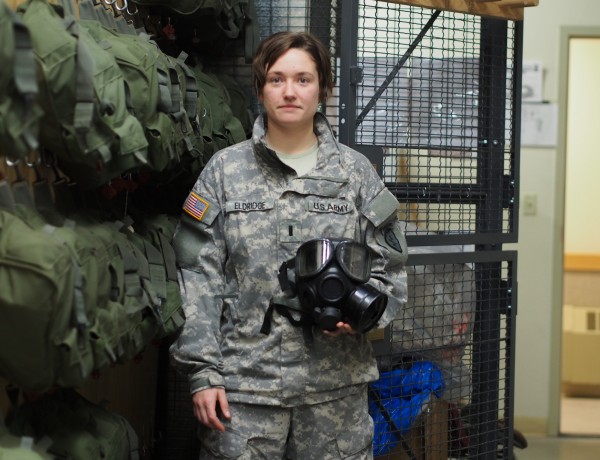Starting next year, all positions in the military will be open to women–everything from tank drivers to Navy SEALs. The decision by Secretary of Defense Ash Carter ends gender prohibitions on about 10 percent of all military jobs. And it could have a big impact on the Army in Alaska.

“I’m a 74-Alpha, which is a chemical, biological, nuclear and radiological officer,” explained First Lieutenant Elizabeth Eldridge, sitting on an office chair inside a metal cage marked by biohazard signs. It’s for storing equipment used by a unit handling Nuclear, Biological, and Chemical tasks, decorated with bags holding gas masks and other equipment you might need if your job involves spotting chemical weapons. The air smells like diesel.
“I came into the military through ROTC from Northern Michigan University,” Eldridge said in a calm voice, “and I’ve been in the Army for two years.”
Eldridge is part of the first wave of women allowed to apply to become Army Rangers–one of the most taxing, elite programs in the Armed Forces. Last summer, the first two women in U.S. history completed Ranger school. Eldridge applied as soon as she could. After passing local qualifying tests in Alaska, she went to Fort Benning in Georgia for a second round of screening earlier this year.
“Our rucks were probably 60 pounds,” she said, recalling a miles-long march in Georgia. “About four miles into the ruck I wasn’t sure I was going to finish, couldn’t keep my ruck on my back, it was dark outside, people were yelling at me, telling me I wasn’t going to make it. But I crossed probably 10 minutes before the time limit.”
Eldridge failed out of that pre-course twice. She hasn’t yet made it to the official Ranger program. Which is par for the course: Most soldiers have to try multiple times before a small minority of them ever make it through school.
Eldridge’s work involves identifying weapons of mass destruction, and she’s certified to parachute into war-zones. But that isn’t enough. Like the Green Berets or Special Forces units across the military, the Rangers are one of the elite units that was completely closed to women. And for Eldridge, finally being allowed to test her limits is part of the reason she thinks it’s worth putting herself through the gauntlet at all.
“I initially wanted to do it because people told me that I couldn’t. I don’t like people saying ‘you can’t do something,'” Eldridge said. “I wanted to prove them wrong.”
Eldridge is also motivated to incorporate the leadership skills and physical rigor of Ranger training into her unfolding career with the Army.
But there’s also that drive to explore what it now means that elite combat positions will finally be open to the soldiers who best qualify for the job.
“There’s just no DOD policy now that’s telling us ‘you can’t even try,'” Eldridge said.
Across the full military about 15 percent of personnel are women, and that tracks about the same for the Army. But women are spread unevenly around different jobs. Public affairs, for example, tends to have more female soldiers and officers. Army infantry units–like the two stationed in Alaska–tend to be either male-dominated or exclusively male.
“We have to look at every job in the Army as being gender neutral,” said Lieutenant Colonel Alan Brown, a spokesman for the Army in Alaska.
Of the 3,800 soldiers in the 4-25th brigade combat team at Joint-Base Elmendorf-Richardson, just 185 are women — less than 5 percent. But according to Brown, the recent conflicts abroad have blurred the lines between combat and non-combat roles in war zones, chipping away at resistance to women on the battle field.
“This is kind of a non-event for a lot of us,” Brown said.
Like past integrations measures in the Armed Forces, Brown sees the end of the gender prohibitions as expanding the pool of qualified candidates for combat roles. “It just opens up the number of people who’ve got your back.”
Criticism of the issue has focused on whether women can meet the standards for field combat–whether that’s the physical strength it takes to carry a wounded soldier, or the endurance required to make make tactical decisions after forgoing sleep and food for days. And Eldridge actually agrees with some of that criticism: She doesn’t want standards eroded, either.
“A lot of the other women that I know are individuals that don’t want the standards to change,” she said. “We want to earn it the way it is now and not have it be handed to us.”
Overall, Alaska has about 22,000 Armed Forces personnel–a number that includes all branches of the service as well as reserves. Each branch will be affected differently. A spokesperson for the Air Force described the changes they’re expecting as “super minimal.”
But the Army is different. Not only are a lot of new infantry positions now open to women, but one of the two brigades is currently restructuring. In the next year or two, as more women decide whether they want to jobs as cavalry scouts, or in field artillery — or as Rangers — the makeup of Alaska’s Army could look a lot different.
“The culture of the Army is going to take a while to change,” Eldridge said. “But, it’s that sense of unknown, because it hasn’t happened.
She is planning to re-apply for Ranger School in the year ahead.
Zachariah Hughes reports on city & state politics, arts & culture, drugs, and military affairs in Anchorage and South Central Alaska.
@ZachHughesAK About Zachariah




